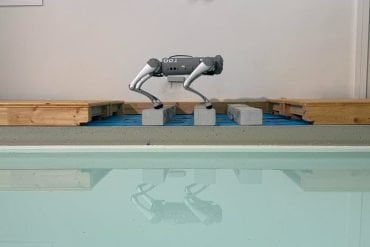Summary: A new study reveals the extent to which experiences can affect brain connectivity. The study used a neurochip with over 4,000 electrodes to track neuronal activity in mice brains.
The results showed that mice living in an enriched environment had far more interconnected neurons than those living in standard environments. These findings not only provide insights into brain plasticity but also have potential applications in artificial intelligence.
Key Facts:
- A team of researchers used a neurochip to observe the neuronal activity in mouse brains and found that an enriched environment significantly boosted interconnections in the neurons.
- The research offers a groundbreaking understanding of brain plasticity and large-scale neural networks.
- The study’s findings have potential implications for artificial intelligence, with the insights helping to potentially inform novel machine learning algorithms.
Source: DZNE
That experiences leave their trace in the connectivity of the brain has been known for a while, but a pioneering study by researchers at the German Center for Neurodegenerative Diseases (DZNE) and TUD Dresden University of Technology now shows how massive these effects really are.
The findings in mice provide unprecedented insights into the complexity of large-scale neural networks and brain plasticity. Moreover, they could pave the way for new brain-inspired artificial intelligence methods.
The results, based on an innovative “brain-on-chip” technology, are published in the scientific journal Biosensors and Bioelectronics.

The Dresden researchers explored the question of how an enriched experience affects the brain’s circuitry. For this, they deployed a so-called neurochip with more than 4,000 electrodes to detect the electrical activity of brain cells. This innovative platform enabled registering the “firing” of thousands of neurons simultaneously.
The area examined – much smaller than the size of a human fingernail – covered an entire mouse hippocampus. This brain structure, shared by humans, plays a pivotal role in learning and memory, making it a prime target for the ravages of dementias like Alzheimer’s disease.
For their study, the scientists compared brain tissue from mice, which were raised differently. While one group of rodents grew up in standard cages, which did not offer any special stimuli, the others were housed in an “enriched environment” that included rearrangeable toys and maze-like plastic tubes.
“The results by far exceeded our expectations,” said Dr. Hayder Amin, lead scientist of the study. Amin, a neuroelectronics and nomputational neuroscience expert, heads a research group at DZNE. With his team, he developed the technology and analysis tools used in this study.
“Simplified, one can say that the neurons of mice from the enriched environment were much more interconnected than those raised in standard housing. No matter which parameter we looked at, a richer experience literally boosted connections in the neuronal networks.
“These findings suggest that leading an active and varied life shapes the brain on whole new grounds.”
Unprecedented Insight into Brain Networks
Prof. Gerd Kempermann, who co-leads the study and has been working on the question of how physical and cognitive activity helps the brain to form resilience towards aging and neurodegenerative disease, attests: “All we knew in this area so far has either been taken from studies with single electrodes or imaging techniques like magnetic resonance imaging.
“The spatial and temporal resolution of these techniques is much coarser than our approach. Here we can literally see the circuitry at work down to the scale of single cells. We applied advanced computational tools to extract a huge amount of details about network dynamics in space and time from our recordings.”
“We have uncovered a wealth of data that illustrates the benefits of a brain shaped by rich experience. This paves the way to understand the role of plasticity and reserve formation in combating neurodegenerative diseases, especially with respect to novel preventive strategies,” Prof. Kempermann said, who, in addition to being a DZNE researcher, is also affiliated with the Center for Regenerative Therapies Dresden (CRTD) at TU Dresden.
“Also, this will help provide insights into disease processes associated with neurodegeneration, such as dysfunctions of brain networks.”
Potential Regarding Brain-inspired Artificial Intelligence
“By unraveling how experiences shape the brain’s connectome and dynamics, we are not only pushing the boundaries of brain research,” states Dr. Amin.
“Artificial intelligence is inspired by how the brain computes information. Thus, our tools and the insights they allow to generate could open the way for novel machine learning algorithms.”
About this neuroplasticity research news
Author: Marcus Neitzert
Source: DZNE
Contact: Marcus Neitzert – DZNE
Image: The image is credited to Neuroscience News
Original Research: Open access.
“High-resolution CMOS-based biosensor for assessing hippocampal circuit dynamics in experience-dependent plasticity” by Hayder Amin et al. Biosensors and Bioelectronics
Abstract
High-resolution CMOS-based biosensor for assessing hippocampal circuit dynamics in experience-dependent plasticity
Experiential richness creates tissue-level changes and synaptic plasticity as patterns emerge from rhythmic spatiotemporal activity of large interconnected neuronal assemblies.
Despite numerous experimental and computational approaches at different scales, the precise impact of experience on network-wide computational dynamics remains inaccessible due to the lack of applicable large-scale recording methodology.
We here demonstrate a large-scale multi-site biohybrid brain circuity on-CMOS-based biosensor with an unprecedented spatiotemporal resolution of 4096 microelectrodes, which allows simultaneous electrophysiological assessment across the entire hippocampal-cortical subnetworks from mice living in an enriched environment (ENR) and standard-housed (SD) conditions.
Our platform, empowered with various computational analyses, reveals environmental enrichment’s impacts on local and global spatiotemporal neural dynamics, firing synchrony, topological network complexity, and large-scale connectome.
Our results delineate the distinct role of prior experience in enhancing multiplexed dimensional coding formed by neuronal ensembles and error tolerance and resilience to random failures compared to standard conditions.
The scope and depth of these effects highlight the critical role of high-density, large-scale biosensors to provide a new understanding of the computational dynamics and information processing in multimodal physiological and experience-dependent plasticity conditions and their role in higher brain functions.
Knowledge of these large-scale dynamics can inspire the development of biologically plausible computational models and computational artificial intelligence networks and expand the reach of neuromorphic brain-inspired computing into new applications.






